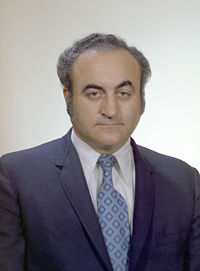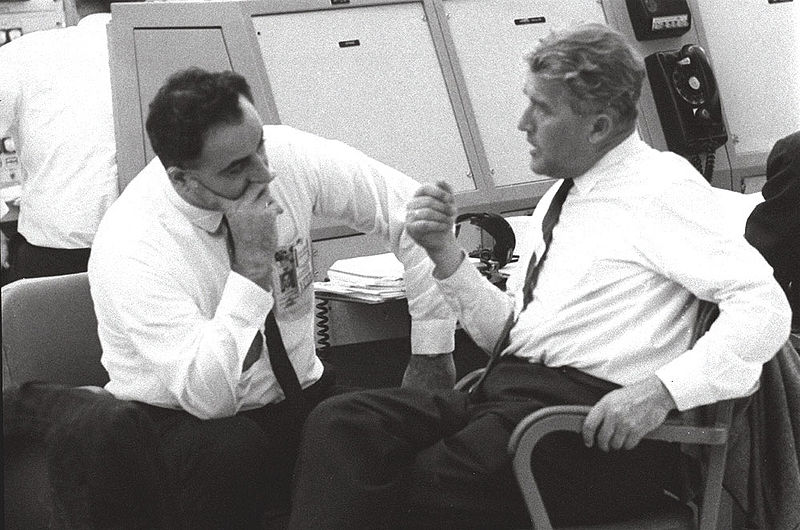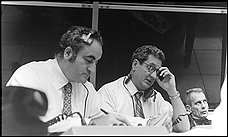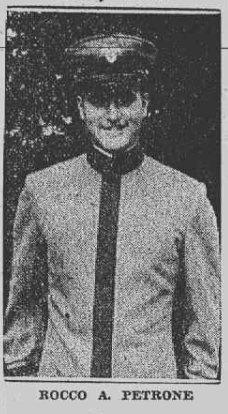He also earned a master's degree in mechanical engineering from the Massachusetts Institute of Technology in 1951 and received an honorary doctorate from Rollins College.[4] During two decades with the U.S. Army, Petrone took part in developing the Redstone rocket, the first U.S. ballistic missile and the vehicle used to launch America's first astronauts, Alan Shepard and Gus Grissom on their suborbital missions. He retired from the Army in 1966 with the rank of lieutenant colonel.
n 1960, Petrone was transferred to NASA.[1] There, Petrone presided over the development of the Saturn V launch vehicle and launch operations, what he dubbed the "five-month marathons," leading up to each launch. He oversaw construction of all the launch elements of the Apollo program, including Launch Complex 39, the Vertical Assembly Building and the Crawler-Transporter, all of which were modified for Space Shuttle operations. He retired from the Army in 1966 but continued at work at NASA sites, being promoted to director of launch operations at KSC that year. Shortly after the Apollo 11 mission, he was appointed director of the entire Apollo program.[5] In 1972, he was assigned additional responsibilities as program director of the NASA portion of the U.S. and the Soviet Union joint Apollo-Soyuz Test Project.[2]
Petrone served for one year as the first non-German administrator of the Marshall Space Flight Center, after Wernher von Braun and Eberhard Rees. At the time NASA was undergoing budget cutbacks, and his tenure was marked with many reassignments or firings.[1] In 1974, Petrone left the Marshall Center to accept an appointment as the third-highest ranking NASA official as associate administrator
In 1975, Petrone retired from NASA and became the president and chief executive officer of the National Center for Resource Recovery, a joint industry/labor effort to develop and encourage ways to recover materials and energy from solid waste. In the 1980s, Petrone held senior posts at Rockwell International, manufacturer of the Space Shuttle Orbiter. He eventually rose to become head of Rockwell's space transportation division.
On the morning that the Space Shuttle Challenger was due to launch on STS-51-L, Petrone and several of his colleagues were alarmed at the massive amount of ice that had built up overnight on the Orbiter due to unseasonably cold temperatures. Petrone feared that the ice could seriously damage the shuttle's thermal protection system when it struck the tiles during launch. He told his managers at Cape Canaveral that Rockwell could not support launching because it viewed the amount of ice on the Orbiter as a launch constraint.[7] This was not the cause, however, of the launch failure that killed seven astronauts.
He died on August 24, 2006 from complications related to diabetes in Palos Verdes Estates, California, aged 80
Rocco A. Petrone, 80, a demanding NASA executive who played crucial administrative roles during the Apollo manned spaceflights to the moon, died Aug. 24 at home in Palos Verdes Estates, Calif. He had a heart ailment and diabetes.
Mr. Petrone worked on the Redstone ballistic missile early in his career as an Army mechanical engineer. He came to the National Aeronautics and Space Administration in 1960 on loan from the Army. From what became Kennedy Space Center in Florida, he worked on construction and development of the Saturn launch rockets. The Saturn rockets were instrumental to the Apollo lunar missions.
As director of Kennedy's launch operations from 1966 to 1969, Mr. Petrone was responsible for every spacecraft component from its arrival at the launchpad until takeoff.
The peak achievement of this period came in July 1969 with the moon landing of Apollo 11. He also was present during the 1967 capsule fire aboard what is often called Apollo 1, and the deaths of the three astronauts had a lasting effect on Mr. Petrone's unremitting manner when it came to quality control, said Roger D. Launius, chairman of the space history division at the National Air and Space Museum.
Humboldt C. Mandell Jr., a retired NASA manager at Johnson Space Center in Houston, recalled in an e-mail a typical encounter with Mr. Petrone at the time: "NASA was grilling the contractor people on some program delays. Rocco was the one who was never content with an answer, and kept probing this one young contractor engineer, who quickly reached the limit of his knowledge.
ad_icon
"Instead of admitting it, he tried to bluff. Bad mistake. Rocco took him physically off of the podium, and told the young man's boss to take the podium. He also told the boss that the young man was to be removed from the program. Brutal? Maybe, but it made us all know our subjects thoroughly from then on."
Mr. Petrone was a towering man, a former football star at West Point, and he usually won arguments, even against superiors. Former NASA deputy administrator Robert C. Seamans Jr. said Mr. Petrone was particularly gifted at explaining the space agency's needs to visiting dignitaries, and this led to close relationships with political leaders.
When he asked for fresh batteries for Apollo 11 during launch testing, few others felt this expensive request was worthwhile. But Kennedy Space Center Director Kurt Debus got this reply from Washington: "If Petrone says he wants it that way, then do it that way."
In 1969, Mr. Petrone succeeded Air Force Gen. Samuel C. Phillips as Apollo program director in Washington. The next year, during the Apollo 13 crisis, Mr. Petrone was a liaison to politicians who wanted to know what had happened and what NASA was doing to bring Apollo 13's crew home safely.
In 1973, Mr. Petrone followed German-born rocket engineers Wernher von Braun and Eberhard Rees as director of the Marshall Space Flight Center in Alabama. Marshall develops spacecraft propulsion systems, but the end of the Apollo era brought a demand for huge staff cutbacks.
Mr. Petrone fired or reassigned many people during his year at Marshall and then ended his career in 1975 as NASA's associate administrator, the agency's third-ranking official.
After an interim with a private energy research group, Mr. Petrone was hired in 1981 by Rockwell International, a California-based defense contractor that built space shuttles. As chief of the space transportation and systems division, he oversaw shuttle design, testing, certification and manufacture.
The space shuttles had flown dozens of successful missions, but on the morning of Jan. 28, 1986, Mr. Petrone cautioned against that day's launch of the shuttle Challenger. His chief objection, overridden by space agency officials, was that subfreezing weather the previous night could have damaged the Challenger's thermal protection tiles.
Seven astronauts were killed on the Challenger when it exploded shortly after takeoff. Subsequent findings showed that the disaster resulted not from ice, but instead from the cold-induced failure of the safety seals known as O-rings within the solid rocket boosters, the two gigantic thrusters that lift the shuttle.
Rocco Anthony Petrone was born March 31, 1926, in Amsterdam, N.Y., a town near Schenectady where his Italian immigrant parents settled. His father, a railroad laborer, died in a work-related accident when Rocco was a baby. His mother, who worked in a glove factory, remarried.
Mr. Petrone, who delivered ice to help support his family, won an appointment to the U.S. Military Academy at West Point, N.Y. He played tackle on a national championship football team with two Heisman Trophy winners, Doc Blanchard and Glenn Davis.
Mr. Petrone graduated from West Point in 1946 and received a master's degree in mechanical engineering from the Massachusetts Institute of Technology in 1951. He rose to the rank of lieutenant colonel before retiring from the Army in 1966.
Survivors include his wife of 50 years, Ruth Holley Petrone of Palos Verdes Estates; four children, Michael Petrone of Palos Verdes Estates, Teresa Petrone of Charlotte, and Nancy Petrone and Kathryn Posey, both of Atlanta; a brother; and a half brother.
He also earned a master's degree in mechanical engineering from the Massachusetts Institute of Technology in 1951 and received an honorary doctorate from Rollins College.[4] During two decades with the U.S. Army, Petrone took part in developing the Redstone rocket, the first U.S. ballistic missile and the vehicle used to launch America's first astronauts, Alan Shepard and Gus Grissom on their suborbital missions. He retired from the Army in 1966 with the rank of lieutenant colonel.
n 1960, Petrone was transferred to NASA.[1] There, Petrone presided over the development of the Saturn V launch vehicle and launch operations, what he dubbed the "five-month marathons," leading up to each launch. He oversaw construction of all the launch elements of the Apollo program, including Launch Complex 39, the Vertical Assembly Building and the Crawler-Transporter, all of which were modified for Space Shuttle operations. He retired from the Army in 1966 but continued at work at NASA sites, being promoted to director of launch operations at KSC that year. Shortly after the Apollo 11 mission, he was appointed director of the entire Apollo program.[5] In 1972, he was assigned additional responsibilities as program director of the NASA portion of the U.S. and the Soviet Union joint Apollo-Soyuz Test Project.[2]
Petrone served for one year as the first non-German administrator of the Marshall Space Flight Center, after Wernher von Braun and Eberhard Rees. At the time NASA was undergoing budget cutbacks, and his tenure was marked with many reassignments or firings.[1] In 1974, Petrone left the Marshall Center to accept an appointment as the third-highest ranking NASA official as associate administrator
In 1975, Petrone retired from NASA and became the president and chief executive officer of the National Center for Resource Recovery, a joint industry/labor effort to develop and encourage ways to recover materials and energy from solid waste. In the 1980s, Petrone held senior posts at Rockwell International, manufacturer of the Space Shuttle Orbiter. He eventually rose to become head of Rockwell's space transportation division.
On the morning that the Space Shuttle Challenger was due to launch on STS-51-L, Petrone and several of his colleagues were alarmed at the massive amount of ice that had built up overnight on the Orbiter due to unseasonably cold temperatures. Petrone feared that the ice could seriously damage the shuttle's thermal protection system when it struck the tiles during launch. He told his managers at Cape Canaveral that Rockwell could not support launching because it viewed the amount of ice on the Orbiter as a launch constraint.[7] This was not the cause, however, of the launch failure that killed seven astronauts.
He died on August 24, 2006 from complications related to diabetes in Palos Verdes Estates, California, aged 80
Rocco A. Petrone, 80, a demanding NASA executive who played crucial administrative roles during the Apollo manned spaceflights to the moon, died Aug. 24 at home in Palos Verdes Estates, Calif. He had a heart ailment and diabetes.
Mr. Petrone worked on the Redstone ballistic missile early in his career as an Army mechanical engineer. He came to the National Aeronautics and Space Administration in 1960 on loan from the Army. From what became Kennedy Space Center in Florida, he worked on construction and development of the Saturn launch rockets. The Saturn rockets were instrumental to the Apollo lunar missions.
As director of Kennedy's launch operations from 1966 to 1969, Mr. Petrone was responsible for every spacecraft component from its arrival at the launchpad until takeoff.
The peak achievement of this period came in July 1969 with the moon landing of Apollo 11. He also was present during the 1967 capsule fire aboard what is often called Apollo 1, and the deaths of the three astronauts had a lasting effect on Mr. Petrone's unremitting manner when it came to quality control, said Roger D. Launius, chairman of the space history division at the National Air and Space Museum.
Humboldt C. Mandell Jr., a retired NASA manager at Johnson Space Center in Houston, recalled in an e-mail a typical encounter with Mr. Petrone at the time: "NASA was grilling the contractor people on some program delays. Rocco was the one who was never content with an answer, and kept probing this one young contractor engineer, who quickly reached the limit of his knowledge.
ad_icon
"Instead of admitting it, he tried to bluff. Bad mistake. Rocco took him physically off of the podium, and told the young man's boss to take the podium. He also told the boss that the young man was to be removed from the program. Brutal? Maybe, but it made us all know our subjects thoroughly from then on."
Mr. Petrone was a towering man, a former football star at West Point, and he usually won arguments, even against superiors. Former NASA deputy administrator Robert C. Seamans Jr. said Mr. Petrone was particularly gifted at explaining the space agency's needs to visiting dignitaries, and this led to close relationships with political leaders.
When he asked for fresh batteries for Apollo 11 during launch testing, few others felt this expensive request was worthwhile. But Kennedy Space Center Director Kurt Debus got this reply from Washington: "If Petrone says he wants it that way, then do it that way."
In 1969, Mr. Petrone succeeded Air Force Gen. Samuel C. Phillips as Apollo program director in Washington. The next year, during the Apollo 13 crisis, Mr. Petrone was a liaison to politicians who wanted to know what had happened and what NASA was doing to bring Apollo 13's crew home safely.
In 1973, Mr. Petrone followed German-born rocket engineers Wernher von Braun and Eberhard Rees as director of the Marshall Space Flight Center in Alabama. Marshall develops spacecraft propulsion systems, but the end of the Apollo era brought a demand for huge staff cutbacks.
Mr. Petrone fired or reassigned many people during his year at Marshall and then ended his career in 1975 as NASA's associate administrator, the agency's third-ranking official.
After an interim with a private energy research group, Mr. Petrone was hired in 1981 by Rockwell International, a California-based defense contractor that built space shuttles. As chief of the space transportation and systems division, he oversaw shuttle design, testing, certification and manufacture.
The space shuttles had flown dozens of successful missions, but on the morning of Jan. 28, 1986, Mr. Petrone cautioned against that day's launch of the shuttle Challenger. His chief objection, overridden by space agency officials, was that subfreezing weather the previous night could have damaged the Challenger's thermal protection tiles.
Seven astronauts were killed on the Challenger when it exploded shortly after takeoff. Subsequent findings showed that the disaster resulted not from ice, but instead from the cold-induced failure of the safety seals known as O-rings within the solid rocket boosters, the two gigantic thrusters that lift the shuttle.
Rocco Anthony Petrone was born March 31, 1926, in Amsterdam, N.Y., a town near Schenectady where his Italian immigrant parents settled. His father, a railroad laborer, died in a work-related accident when Rocco was a baby. His mother, who worked in a glove factory, remarried.
Mr. Petrone, who delivered ice to help support his family, won an appointment to the U.S. Military Academy at West Point, N.Y. He played tackle on a national championship football team with two Heisman Trophy winners, Doc Blanchard and Glenn Davis.
Mr. Petrone graduated from West Point in 1946 and received a master's degree in mechanical engineering from the Massachusetts Institute of Technology in 1951. He rose to the rank of lieutenant colonel before retiring from the Army in 1966.
Survivors include his wife of 50 years, Ruth Holley Petrone of Palos Verdes Estates; four children, Michael Petrone of Palos Verdes Estates, Teresa Petrone of Charlotte, and Nancy Petrone and Kathryn Posey, both of Atlanta; a brother; and a half brother.






